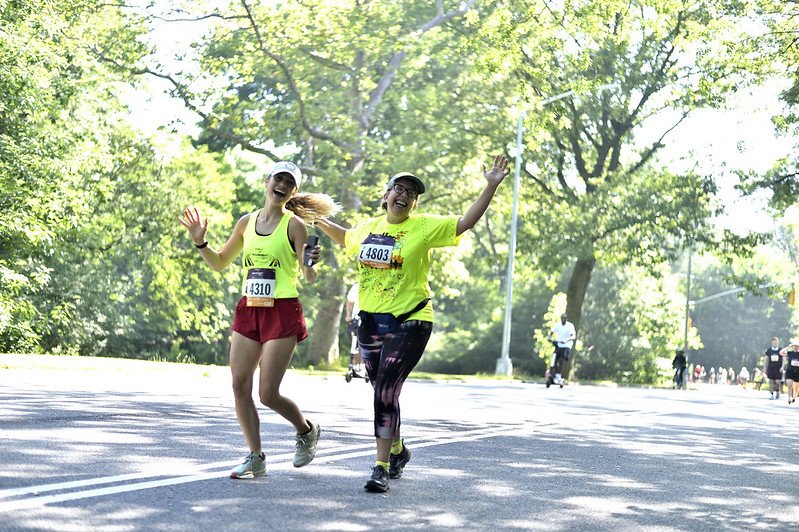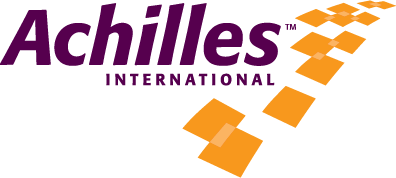
Achilles Training Hub
Whether you are working toward your very first 5K, or you are looking for ways to improve on your already solid marathon times, Achilles wants to help you achieve your goals. The workout plans below are written so that walkers, runners, or rollers could all find it valuable. We have created training programs for four distances: 5K, 10K, half-marathon, and full marathon. For each distance we have two different tracks, dependent on your projected finishing goals. So, no matter how much you’re currently doing, we’ve got the plan for you. In this training hub we use the word “running”, but it applies to any way you want to move.
The intention of this program is to give you a training schedule to fit your experience and ambitions and complement your chapter workouts. If you live in a city where your chapter lead has coaching certification, they can work with you to customize your plan to meet your goals and help you keep a training diary.
Purple Plans
Perfect for first timers, walkers and those with a pace 12:00 minutes per mile or greater.
5K
First time or over 35 minutes
10K
First time or over 1:15 hours
Half Marathon
First time or over three hours
Marathon
First time or over five hours
Orange Plans
Perfect for experienced athletes and those with a pace between 7:00-11:00 per mile.
5K
Experienced or under 35 minutes
10K
Experienced or under 1:15 hours
Half Marathon
Experienced or under 3 hours
Marathon
Experienced or under 5 hours
All plans have been reviewed by a certified USAT and RRCA running coach. Please check with your doctor before beginning any running program to avoid and reduce the risk of injury. Participation in any form of physical activity has inherent risk.
Key Terms and Definitions
Below are concepts and definitions that will be important for your program. The best way to prepare for a race is not just to run the same distance every workout. Doing the same workout each week doesn’t exercise all the energy systems that your body uses when you run. Your racing plan will differ in levels of intensity, and this document will help you understand how to do these workouts. Said differently, to prepare your body you need to practice aerobically and anaerobically.
Speeds
In your workout schedule, you will find different levels of distance and effort. This will make you a better all-around athlete, no matter how much experience you have already. You will have workouts that ask for three different levels of effort, which we will call Easy, Moderate, and Fast. It’s important to understand what those three levels mean to you, because the actual speeds for these levels are different for everyone. Below are three ways to describe what Easy, Moderate, and Fast actually mean.
Rate of Perceived Exertion Method
This is also called the “RPE Method”, or Rate of Perceived Exertion. The easiest way of thinking about the three different levels of effort is by thinking about running while you are having conversation or analyzing how heavy your breathing is. If you are moving at an Easy pace, you should be able to have an unrestricted and continuous conversation. You should feel as free to talk with your running partner as if you were just standing around. Your breath should be steady and feel comfortable. If you are walking or running at a Moderate pace, you should be able to say one or two sentences, but at the end of that you will feel slightly out of breath. You will be breathing actively but the breaths should stay even. Finally, if you are running at a Fast pace, you should be struggling to speak at all. Maybe you can ask or answer a question, but you will definitely want to wait a bit before you do it again. At this pace, you will feel like you are trying to catch your breath.
Heart Rate Method
This method uses a heart rate monitor, which is not required, but is the most straightforward way to define different levels of effort. The heart rate monitor will either be a chest strap (the most accurate measurement) or watch with heart rate capability. It works like this. Start with the number 220, and subtract your age. The resulting number is considered the top heart rate that your body can work at, and only for a short period of time. So, if you are 30 years old, your top heart rate is 190. The Easy, Moderate, and Fast speeds are all percentages of this 190. Fast is considered 10% below your maximum, or in our example from 171 to 190. Moderate is considered 75% to 90% of your maximum heart rate. In our example this is 142 to 170. Finally, Easy is considered anything below 141. Below are some sample calculations:
| Age | Age | Age | Age | |
|---|---|---|---|---|
| 220-Age Equation | 25 | 35 | 50 | 70 |
| Max Heart Rate | 195 | 185 | 170 | 150 |
| Fast | 176 to 195 | 167 to 185 | 153 to 170 | 135 |
| Moderate | 146 to 176 | 139 to 167 | 128 to 153 | 113 to 135 |
| Slow | Below 146 | Below 139 | Below 128 | Below 128 |
Pace Zones
Finally, the Pace Zones method of defining speed is the most precise. In order to calculate this you will need to run a little workout. Warm up for 10 minutes at a slow jog. When you are ready to start, run at a very fast pace, but at a pace you can maintain for 20 minutes. You want to be running the same speed for the full 20 minutes. This is your “Top Pace”. This pace will be used to determine the three levels of effort. Your Fast speed is from 90% of your top pace up to your top pace. The Moderate speed is from 75% to 90% of your Fast speed, and your Easy speed is anything less than 75% of your max speed.
Putting It All Together
Now that we know what Easy, Moderate, and Fast are, we are ready to see how they are used in the workout plans. At the beginning of any workout, you should always warm up a little bit. The exact warm up depends on how hard the workout is, but generally you should be active for at least 5 minutes. Something dynamic is best – jumping jacks, windmills, knee lifts etc. When you are ready for your workout, follow the instructions. Sometimes this will be very straight forward, like “20 Minute run at Moderate Pace”. Sometimes this will be strides (more on this next). At the end of the workout you should cool down and stretch.
Stride Workouts
Stride workouts are also called intervals, or sprint training. Essentially stride workouts are time periods of Fast pace followed by periods of Easy pace. For example, one of your workouts may be something like “6 X 20 Second Stride with 1 min Easy recovery”. What that means is that you will run at a Fast pace for 20 seconds, and then you will jog at an Easy pace for 1 minute. You will do this sequence a total of 6 times. Stride workouts are a great way to improve your power, a necessary part of running even long distances. When you’re done, don’t forget to run 5-10 minutes to cool down, and stretch.
“In 1991, at the age of 11, I was diagnosed with osteosarcoma (bone cancer) and given six weeks to live. A clinical trial in Boston, where I spent countless days in the hospital watching people run along the Charles River Esplanade, saved my life. One day in April 1991, I asked my nurse why so many people were running. She told me they were probably training for the Boston Marathon. I told her I was going to do the Boston Marathon IF I grew up. Twenty-eight years later, almost to the day, I crossed the finish line and became the Women’s Handcycle Champion of the 2019 Boston Marathon. Without Achilles International, I would never have had the opportunity to try to make a dream a reality.”
— Devann Murphy, Achilles Athlete, Keeseville, NY

